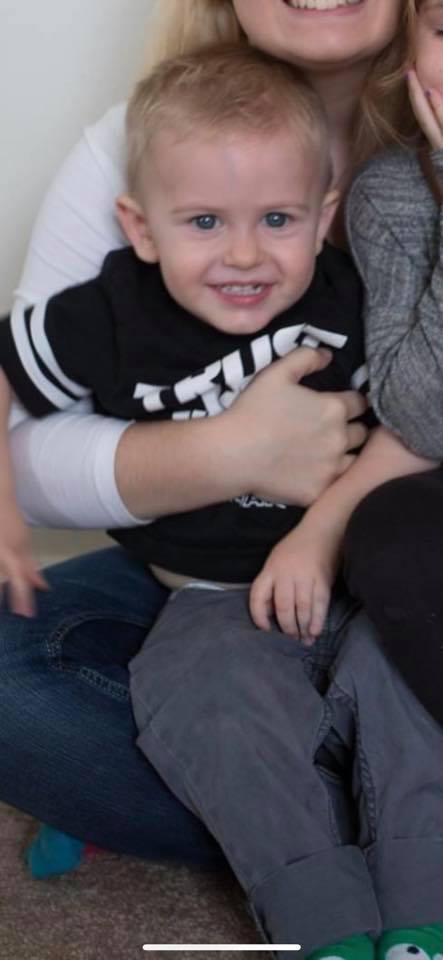The young boy was a happy, energetic toddler with no history of illness until one August morning when everything changed. What began as a seemingly routine stomach bug soon evolved into a tragic sequence of events that no one had anticipated.
In 2016, what started as a fun-filled August quickly turned into a nightmare for Kayla and Brent Dunham. One morning, their toddler, Grayson Dunham, woke up with what appeared to be a common stomach bug. His parents brought him to doctors repeatedly, only to be handed a series of misdiagnoses, five in total, that delayed the urgent treatment he needed.
The real culprit — a serious condition that typically begins with a seemingly ordinary infection — was identified too late. In the wake of her unimaginable loss, her instinct was to warn other parents: a child’s health can decline in an instant, and it is crucial to recognize early warning signs and push for swift, comprehensive medical attention.
He Was Always So Healthy
Grayson wasn’t the kind of child who caught every cold going around. At just two, he was full of energy, curious, active, and thriving. That summer of 2016, his parents, Kayla and Brent, made the most of the warm weather, taking him to a local state fair, a petting zoo, and out to eat at some of their favorite restaurants.
It was all part of an ordinary August in Sheridan, Indiana. Then, on the morning of Wednesday, August 10, Grayson woke up vomiting and had diarrhea. At first, Kayla wasn’t overly alarmed. Like most parents would, she assumed it was a common stomach bug. He still seemed alert and responsive, and she focused on keeping him comfortable and hydrated.

Grayson Dunham pictured with his parents, Kayla and Brent, dated August 15, 2026 | Source: Facebook/kayla.mosson
But by the next day, his symptoms hadn’t improved. Thursday passed much the same, and Grayson still hadn’t bounced back. As the symptoms became more concerning, his parents knew they needed answers. What they didn’t know was that a dangerous infection had already begun attacking their son’s small intestine, and that time was slipping away.
One Visit After Another, Still No Clear Answers
On Friday afternoon, August 12, Kayla took Grayson to the pediatrician, concerned that his symptoms were getting worse. The doctor examined him and diagnosed the illness as a stomach flu, a common viral infection in young children. The family was advised to keep him hydrated and comfortable at home.

Grayson Dunham pictured with his dad, Brent, dated August 15, 2026 | Source: Facebook/kayla.mosson
But by that evening, Grayson’s condition deteriorated. His discomfort intensified, and he was now experiencing what his parents believed to be significant abdominal pain. That night, he barely rested at all — just an hour or so — due to discomfort they assumed was tied to his ongoing digestive issues.
Then came a troubling sign: possible blood in his stool, which added urgency to their growing concern. The following morning, Saturday, they returned to the pediatrician. By this point, Grayson was dehydrated, still vomiting, and his diarrhea continued, now with unmistakable signs of blood.

Grayson Dunham pictured with his mom, Kayla, dated August 15, 2026 | Source: Facebook/kayla.mosson
The doctor agreed that he needed hospital care and arranged for his admission to IU Health Riley North Hospital in Indianapolis. From there, a sequence of changing diagnoses began. Despite worsening symptoms, no one could pinpoint what was wrong.
“We were misdiagnosed five times,” Kayla later revealed. When they returned to the pediatrician that day, the doctor recognized signs of dehydration and recommended hospital admission.

Photo of Grayson Dunham, dated August 15, 2026 | Source: Facebook/kayla.mosson
Escalating Symptoms and Emergency Admission
At IU Health Riley North, the staff administered fluids and began imaging tests to determine the source of Grayson’s pain. Initial imaging included chest and abdominal X-rays, along with multiple ultrasounds. Yet none of the results offered clear answers.
Doctors first suspected intussusception, a condition where part of the intestines folds over itself, causing intense, episodic pain. They saw it as a possible explanation of why Grayson appeared fine between painful episodes. But without catching it during an active pain episode, doctors couldn’t confirm it.

Grayson Dunham, dated August 15, 2026 | Source: Facebook/kayla.mosson
Next, they considered Henoch-Schönlein purpura (HSP), an inflammatory condition involving the blood vessels that can sometimes coincide with or mimic intussusception. But once again, the tests didn’t support a conclusive diagnosis. Doctors continued looking for answers as Grayson’s condition became more alarming.
Then, concern shifted to Grayson’s appendix, which was thought to be enlarged. Meanwhile, his condition kept deteriorating. Diarrhea every 10 minutes. Sharp, unrelenting pain. The toddler was slipping away while adults scrambled for answers.

Grayson Dunham with his dad, dated August 15, 2026 | Source: Facebook/kayla.mosson
Faced with the possibility that surgical intervention might be needed, the team decided to transfer Grayson to Riley Hospital for Children in downtown Indianapolis, where more advanced pediatric resources were available. But even there, clarity remained out of reach.
Transferred and Diagnosed Too Late
At Riley Hospital for Children in downtown Indianapolis, Grayson was still in excruciating pain. He was immediately sent for further testing. This time, doctors spotted severe inflammation, not of the appendix, but of his colon. The new working diagnosis was colitis. He was placed in the intensive care unit to prepare for any sudden complications.

Grayson Dunham, dated June 21, 2020 | Source: Facebook/kayla.mosson
But even in the ICU, Grayson’s symptoms defied expectations. His abdomen, once soft, began to harden. He could barely tolerate movement, and pain medications were offering little relief. By Sunday, the doctors delivered yet another diagnosis, this time, with certainty: Hemolytic Uremic Syndrome (HUS).

Grayson Dunham, dated June 21, 2020 | Source: Facebook/kayla.mosson
It was the fifth explanation Grayson’s parents had been given, and the most serious. His kidneys were no longer functioning properly, and his blood pressure had reached dangerous levels. He was in intense pain despite multiple rounds of medication.

Grayson Dunham, dated June 21, 2020 | Source: Facebook/kayla.mosson
To ease the stress on his kidneys, the plan was to insert a central line and begin dialysis the following day. A feeding tube was placed first, and to Kayla’s relief, it provided some comfort. Grayson was even able to talk and watch videos again. His oxygen levels stabilized. His blood pressure went back to normal. For a brief moment, it looked like they’d turned a corner.

Grayson Dunham, dated June 21, 2020 | Source: Facebook/kayla.mosson
That hope unraveled in the early hours of August 15. Doctors noticed his hemoglobin levels — the protein in red blood cells that carries oxygen — had plummeted from normal to near zero. His heart stopped. A team of over 20 medical professionals performed CPR for nearly two hours. But nothing could bring Grayson back. At 4:30 a.m., Kayla and Brent were told their son was gone.

Grayson Dunham with his mother, dated June 21, 2020 | Source: Facebook/kayla.mosson
In a Facebook post, Kayla described the moment with clarity, “We are in [utter] shock, our bodies are numb, and there are no words to describe the pain we are in. Our sweet, handsome, smart, outgoing little boy was taken from us too soon for reasons we will never understand.”

Grayson Dunham with his mother, dated June 21, 2020 | Source: Facebook/kayla.mosson
The Devastating Reality of HUS
What ultimately claimed Grayson’s life was a condition few parents have even heard of: Hemolytic Uremic Syndrome. It’s as frightening as it is rare, a complication that can arise from something as simple as a child’s day at the fair or a family dinner out.

Grayson Dunham, dated June 21, 2020 | Source: Facebook/kayla.mosson
HUS is most often triggered by a Shiga toxin-producing strain of E. coli, the kind that attacks from the inside. The toxin damages the delicate lining of blood vessels, particularly in the kidneys, causing red blood cells to rupture.
The result is a cascade of complications: destruction of red blood cells, dangerously low platelets, and kidney failure. In Grayson’s case, that internal destruction moved fast. His hemoglobin plummeted. His kidneys faltered. His tiny body, just days before full of energy, was shutting down.
The symptoms of HUS often appear deceptive at first, as they often mimic a severe stomach bug. They include diarrhea, sometimes bloody; abdominal pain; nausea; and fever. It can rapidly progress to more alarming signs like pallor, confusion, high blood pressure, and in some cases, seizures or stroke.
While HUS can affect anyone, young children are particularly vulnerable. Without timely intervention — including hospitalization, IV fluids, and sometimes dialysis — the condition can quickly become fatal. Each misstep, each delayed diagnosis, gave the infection more time to do irreversible damage to Grayson’s body.
Grayson’s parents learned that many of his symptoms, bloody diarrhea, high blood pressure, abdominal pain, and severe fatigue, were classic signs of the illness. But up until that point, no one had tested him for it. The origin of the E. coli remains a mystery.
Was it the petting zoo? A contaminated meal? Unwashed produce? Kayla and Brent were told they may never know. That uncertainty haunted them, but also fueled Kayla’s mission to make sure no other parent is blindsided by a diagnosis they’ve never been warned about.
A Mother’s Plea to Fellow Parents
Just two days after Grayson’s death, Kayla posted on Facebook, “Please share the story of my sweet baby boy. He will never be forgotten. And I will do everything in my power for his legacy to live on.”
She later explained why she went public so quickly. Her goal was to warn other families about the signs she wishes she had recognized sooner. Kayla now encourages other parents to take action when their children show signs of severe illness, especially symptoms like bloody diarrhea, abdominal pain, vomiting, or fever.
She emphasizes that it’s okay to request a stool sample, ask questions, and do independent research during the diagnostic process. After losing Grayson, she signed up for FDA food safety alerts and remained vigilant about hygiene, including thorough handwashing and food handling.
The family has set up a fund in Grayson’s name at Riley Children’s Hospital to honor his memory. Her message was clear: don’t wait, don’t assume, and don’t be afraid to speak up.

